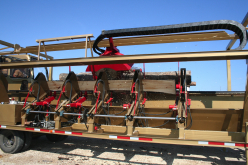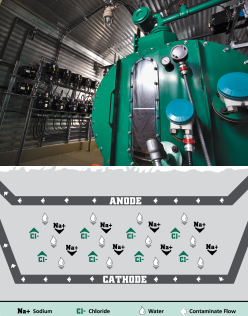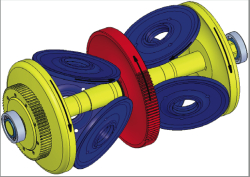
Design Exchange Awards
By Design Engineering staff
General awards InnovationCanadian inventors recognized for their innovative creations

Award of Excellence
Product: Twin-Cut
Company: DavCo Solutions
For the last decade or so, declines in the forestry industry have seen the closure of large sawmills, forcing smaller communities to pay huge transportation costs to process their timber. Similarly, certain areas of the North America, Russia and South America present large logging opportunities but the lack of infrastructure and environmental impacts push costs beyond viability.
Enter the Twin-Cut Mobile Sawmill from Grande Prairie, AB-based DavCo Solutions Inc. The brain child of semi-retired forestry entrepreneurs Les Oilund and DavCo’s founder, Dave Fenton, the 24,500-pound, 49-foot long Twin-Cut is a fully portable sawmill that can churn out 20,000 board-feet per 8-hour shift and handle 8 to 20-foot-long logs that are up to 28 inches in diameter.

At its most basic operation, the Twin-Cut can square off logs making them easier and more efficient to transport. However, in many situations, the portable sawmill eliminates the need to send raw timber miles away for processing.
“One area where it’s being used locally is in the oil fields, where they have to log off their lease sites,” says Mike Dyck, operations manager for Davco Solutions. “Before, they would have to pay to get rid of the wood and then pay to bring it back as different products. Now, they can saw it right there where it was logged and use it for things like blocking to put underneath their camps or building bridges.”
At the heart of the Twin-Cut’s flexibility and portability is its unique saw head. Instead of one blade with a radius large enough to handle various-sized trees, the Twin-Cut utilizes two opposing 26-inch blades, a configuration that not only saves space but also allows the saw head to cut in two directions.
Once the blades make their initial cut down the length of the timber, the log is flipped flat face down. The saw head then rotates 180 degrees about its x-axis so that its combined cutting edge faces back in the opposite direction for the next pass. The log itself is secured by “dogs” or pinchers that hold the piece until all the back-and-forth saw passes either square the timber for transport or cut it into pre-defined planks.
The machine is powered by a 174 HP John Deere diesel motor that drives two Sauer-Danfoss hydraulic pumps—one for the saw blades and one for all the other components (dogs, chain drive system, conveyors, etc.). For control, the machine incorporates a Siemens industrial computer custom-programmed by Don MacNiven, owner/operator of Grande Prairie’s Javelin Technical Solutions. Within the Twin-Cut’s temperature-controlled cab, a touch-screen HMI allows the operator to manipulate the log and set the number of passes desired.
“Every time the saw goes to the far end and rotates, the computer tells the control to move the lumber ahead for the next pass,” Dyck explains. “That way, the operator doesn’t have to factor in the curve thickness of the saw blade plus the board thickness and nobody has to get in the work space to reposition the lumber.”
Dyck says it took two years for the Twin-Cut to go from concept to the production of the first saleable model. Sales have built slowly in the first few months since it debuted last summer but the company has received inquires from loggers in Siberia and South America where limited infrastructure makes transportation challenging.
www.davco.ab.ca
Award of Excellence
Product: EK3 Electrokinetic Salt Remediation System
Company: Ground Effects Environmental Services Inc.
In order to get at oil, companies typically drill through a layer of salt, and on top of that, the water used in the drilling process, along with the groundwater, is mixed with this salt. This water is extracted and, in the past, had been dumped on site and the salt seeped into the ground. Nowadays, it is taken off site to a storage facility, but spills still happen. To ensure the Western Canadian energy boom does not become an environmental bust, a Regina-based company has uncovered a way to wash away the oil industry’s dirty footprints.

To reverse this contamination, Ground Effects Environmental Services Inc. has developed its patented EK3 Electrokinetic Salt Remediation System, which harnessed the power of electricity to clean up contaminated salt sites in an environmentally friendly way.
High salt concentrations are toxic to vegetation, creating environmental and aesthetic impacts, so electrokinetic remediation is a process in which a low-voltage DC electric field is applied across a section of contaminated low-permeability soil in order to move and extract contaminants. This has the ability to treat soils such as clay, silt or till contaminated with metals, nitrates, chlorides, sulfates and salts in situ with little environmental disturbance. The only other method previously available to customers was “dig and dump,” which the company says can be an environmental and public relations nightmare.
Electrokinetics is a big word for a fairly simple process: When an electric field is created, the NaCl molecules (salt) are separated into Na+ (sodium) and Cl- (chloride) ions. Direct current power supplies are utilized in order to control the amperage or voltage supplied to the system, and they can supply a constant current at minimal amperage and voltage depending on soil conductivity. The electric field pulls the free Na+ ions in the direction of the negative electrode and the free Cl- ions in the direction of the positive electrode. Na+ and Cl- collect at the opposite charged electrodes and then are pumped to the surface where the water is treated until clean.
The EK3 system can be controlled over the Internet using the company’s satellite telemetry technology. There are three conditions monitored in this technology: pH, temperature, and gases produced. The pH of the two plumes and the temperature of the soil are controlled by a flushing method. If the pH gets out of the optimal range or the temperature gets too high, the system will be shut down and be flushed with fresh water until the pH and temperature meet the parameters set.
When GEE first began developing its EK3 system, it had wanted to create a market advantage by developing a technology that no other company offered. More recently, the company has “lucked out” with regards to new legislation requiring oil and gas customers to tidy up sites or face penalties. “New regulations are coming out all the time and making companies clear old sites before they can move on and explore new sites,” says business development manager Calvin Prokop. “Rather than doing it for the environment’s sake, it’s starting to affect their bottom line.”
Thank to this and many other factors since production began in summer 2007, the company has exceeded its sale projections to date and have won a National Research Council Innovation Leadership Award.
www.groundeffects.org
Award of Merit
Company: CVT Corp.
Product: VariGen
In applications where a generator-set (motor/generator unit) serves as the primary power source, fuel efficiency almost always takes a back seat to power output and instant availability. In most circumstances, the gen-set’s motor has to run continuously at full speed even when power demand is low. If there were a way to allow the motor to dynamically match its speed to the load being placed on the generator, tanker-loads of expensive diesel fuel could be saved.

That’s the idea behind the VariGen, a prime power gen-set developed by Daniel Girard, president/CEO, and Samuel Beaudoin, VP and co-founder of Montreal-based CVT Corp. With it, fuel efficiency increases by 25 to 30 percent although some customers have seen much higher savings, says Ken Huston, a designer for CVT Corp.
“Oil companies in Alberta are using our system to run their pump jacks,” he says. “They’ve got those things running 24/7 and the kind of fuel they go through is mind blowing. Using our system, they are saving over 75 percent on gas.”
The VariGen achieves these savings by way of a continuously variable transmission (CVT), designed and manufactured by CVT Corp., which allows the motor to speed up or slow down based on power demand, yet maintain the 1800 rpm output speed the alternator requires. The transmission itself is composed of steerable rollers compressed between outer “driving” disks and an inner “driven” disk, under 10 tonnes of pressure. By changing the angle of the rollers, the target input/output ratio is achieved.
“It’s really just a big thrust bearing,” Huston explains. “There are races on either side but, instead of ball bearings, there are rollers. By changing the angle of the disks, the system can switch from underdrive, to a 1 to 1 ratio, to overdrive and all increments in between.”
The CVT concept has been around for nearly a century, but Huston says CVT Corp’s purely mechanical, fully toroidal design has only become possible in recent years. Made from bearing grade steel, the CVT eliminates metal on metal contact by using specially formulated traction fluid that temporarily solidifies under high pressure, providing traction between the rolling surfaces.
The benefit of this mechanical design, Huston says, is that instead of sophisticated electronics, the VariGen uses two simple control loops – one senses electrical demand and varies engine speed; the other assures that the CVT’s ratio keeps a constant output speed of 1800 rpm. The actual ratio change is achieved by steering the CVT’s rollers into position using a ball screw and 12v dc motor.
“Essentially, it’s similar to the way you steer a bicycle,” Huston says. “Our CVT keeps its equilibrium in any given ratio the same way a bicycle will keep a straight line when you let go of the handlebars. This means the controls only position the six rollers in the required ratio, while each roller steers and finds its own equilibrium mechanically.”
While the VariGen is the first commercially-available application of CVT Corp’s transmission technology, the company is presently adapting it for agricultural vehicles and working on a miniature version for the aerospace market.
www.cvtcorp.com
